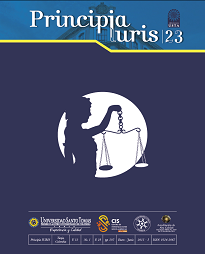GIORGIO AGAMBEN: LOS PARADIGMAS SOCIALES Y SUS APORTES A LA FILOSOFÍA DEL DERECHO
##plugins.themes.bootstrap3.article.main##
Resumo
##plugins.themes.bootstrap3.article.details##
Por medio de esta comunicación certifico que el artículo que estoy presentando para posible publicación en la revista institucional impulsada de la Facultad de Derecho de la Universidad Santo Tomás seccional Tunja, Principia Iuris, es de mi entera autoría, siendo sus contenidos producto de mi directa contribución intelectual.
Todos los datos y referencias a publicaciones hechas están debidamente identificados con su respectiva nota bibliográfica y en las citas que se destacan como tal.
Por todo lo anterior, declaro que el material presentado se encuentra conforme a la legislación aplicable en materia de propiedad intelectual, y por lo tanto, me hago responsable de cualquier reclamación relacionada a esta.
En caso de que el artículo presentado sea publicado, manifiesto que cedo plenamente a la Universidad Santo Tomás seccional Tunja los derechos de reproducción del mismo y accedo a las modificaciones que de forma se requieran para adaptarse a la estética de la revista. Como contraprestación de la presente cesión, declaro mi conformidad de recibir (2) ejemplares del número de la revista en que aparezca mi artículo.
Referências
Agamben, G. (2005). Lo que queda de Auschwitz. El archivo y el testigo. (A. Gimeno, trad.). Valencia, España: Pre-textos.
Agamben, G. (2006). Homo sacer. El poder soberano y la nuda vida. (A. Gimeno, trad.). Valencia, España: Pre-textos.
Agamben, G. (2009). Signatura rerum. Sobre el método. (F. Costa & M. Ruvituso, trads.). Buenos Aires, Argentina: Adriana Hidalgo.
Agamben, G. (2011). ¿Qué es un dispositivo?. (R. Fuentes Rionda, trad.). Sociológica, 26 (73), 249-264.
Arendt, H. (2010b). Los orígenes del totalitarismo. (S. Giner, trad.). Madrid, España: Alianza.
Bacarlett Pérez, M. L. (2010). Giorgio Agamben, del biopoder a la comunidad que viene. Araucaria. Revista Iberoamericana de Filosofía, Política y Humanidades, 12(24), 29-52. Recuperado de http://www.redalyc.org/artículo.oa?id=28214786002
Benveniste, E. (1969). Vocabulario de las instituciones indoeuropeas. (M. Armiño, trad.). Madrid, España: Taurus.
Cantarella, E. (1991). Los suplicios capitales en Grecia y Roma. Orígenes y funciones de la pena de muerte en la antigüedad clásica. (M.P. Bouysson & M.V. García Quintela, trad.). Madrid, España: Akal.
Castro, E. (2004). El vocabulario de Michel Foucault. Un recorrido alfabético por sus temas, conceptos y autores. Buenos Aires, Argentina: Prometeo Libros & Universidad Nacional de Quilmes.
Castro, E. (2008). Giorgio Agamben. Una arqueología de la potencia. Buenos Aires, Argentina: Jorge Baudino editores & Universidad Nacional de General San Martín.
Fanlo, L.G. (2011). ¿Qué es un dispositivo?: Foucault, Deleuze, Agamben. A Parte Rei: Revista de Filosofía, (74), 1-8. Recuperado de http://serbal.pntic.mec.es/~cmunoz11/ fanlo74.pdf
Foucault, M. (2006). Seguridad, territorio y población. Curso en el Collège de France (1977-1978). (H. Pons, trad.). México, D.F, México: Fondo de Cultura Económica.
García, C. (2009). Prometeo: Mito y Literatura. Madrid: España: Fondo de Cultura Económica.
Kertész, I. (1998). Un instante en el paredón. El holocausto como cultura. (A. Kovac¬sics, trad.). Barcelona, España: Herder.
Kuhn, T. S. (2006). La estructura de las revoluciones científicas. (C. Solis, trad.). Ma¬drid, España: Fondo de Cultura Económica.
Morin, E. (2000). Los siete saberes necesarios para la educación del futuro. Bogotá: Colombia: Ministerio de Educación Nacional.
Revel, J. (2009). Diccionario Foucault. (H. Pons, trad.). Buenos Aires, Argentina: Nueva Visión.
Ruiz Gutiérrez, A. (2012b). Walter Benjamin: Para una crítica a la violencia del dere¬cho. Estudios de Derecho, LXV (145), 81-106.
Ruiz Gutiérrez, A. (2013). La violencia del derecho y la nuda vida. Medellín, Colombia: Universidad de Antioquia.
Sofsky, W. (2004). Tiempos de horror. Amok, violencia, guerra. (I. García Adánez, trad.). Madrid, España: Siglo XXI.
Sofsky, W. (2006). Tratado sobre la violencia. (J. Chamorro Mielke, trad.). Madrid, España: Abada.
Sucasas, A. (2000). Anatomía del Lager (Una aproximación al cuerpo concentracio¬nario). Isegoría, (23), 197-207.
Weil, S. (2000). Escritos de Londres y últimas cartas. (M. Largura, trad.). Madrid, España: Trotta.
Weil, S. (2005). La fuente griega. (J. Escartín & M. Escartín, trad.). Madrid, España: Trotta.

